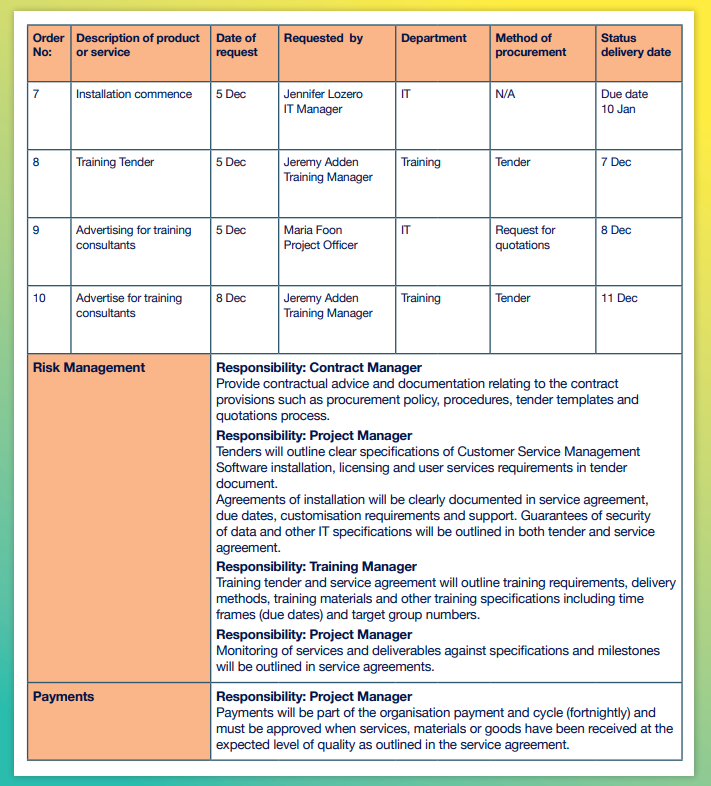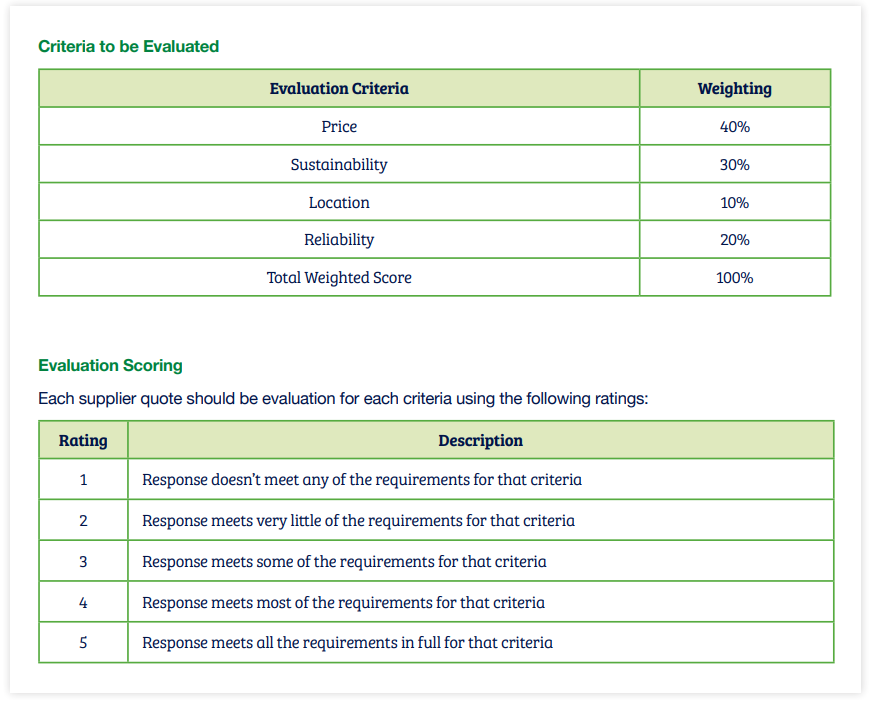Procurement planning is a critical process in any business or organisation that deals with the procurement of goods and services. This module focuses on developing the necessary skills and knowledge to identify suppliers, determine procurement methods, establish a plan and prepare for procurement activities.
To successfully plan and execute a procurement process, it is essential to understand the fundamental principles and procedures involved. We will explore the basics of procurement, including the difference between procurement and purchasing, procurement planning steps, procurement documents, stakeholders, organisational policy frameworks for procurement, and methods to solicit quotations from suppliers. We will also take a closer look at the Commonwealth Procurement Rules (CPRs), which are mandatory for all Commonwealth entities and provide a framework for ensuring that procurement is conducted with integrity, transparency, and accountability.
By understanding these basic principles, you will be equipped with the knowledge to plan and execute a successful procurement process.
Procurement is the process of acquiring goods or services, from the point of identifying a need to the point of delivery or completion of the project. Procurement involves various steps, such as identifying requirements, finding suppliers, negotiating contracts, managing supplier performance, and ensuring the timely delivery of goods or services.
Here are two examples of procurement:
- A construction company needs to procure materials, equipment, and services for a new building project. The procurement process involves identifying specific needs, finding potential suppliers, evaluating proposals, negotiating contracts, and managing the delivery of materials and services to the construction site.
- A government agency needs to procure software and hardware to upgrade its computer systems. The procurement process involves identifying the specific requirements, researching potential vendors, evaluating proposals, negotiating contracts, and managing the implementation and maintenance of the new system.
Procurement is the systematic process of planning, sourcing, and obtaining goods or services. Purchasing refers only to the act of buying or paying for goods or services. Purchasing is one part of the procurement process.
Procurement planning is essential for organisations as it allows them to effectively manage their spending and ensure that they are obtaining the goods and services they need at the right time, quality, and price. Without proper procurement planning, organisations run the risk of overspending or underspending, as well as encountering delays in obtaining necessary items. Proper procurement planning can help to reduce costs, ensure timely delivery, and minimise risks associated with the procurement process. Additionally, it can help organisations to establish better relationships with their suppliers and improve their overall efficiency and effectiveness.
Procurement planning involves the following five steps:
This is the first step in procurement planning, where the procurement team identifies the goods and/or services that need to be acquired to fulfil the needs of the organisation This can involve an assessment of current inventory levels, analysis of demand patterns, and consultation with various stakeholders to determine the exact requirements.
Once the goods or services have been identified, the procurement team needs to develop detailed specifications that outline the required quality, quantity, and delivery timelines. These specifications are essential as they ensure that the goods or services meet the organisation’s needs, and they also form the basis of the procurement evaluation process.
In this step, the procurement team identifies potential suppliers who can provide the goods or services required. They need to determine the best approach to the market, which may involve issuing requests for information (RFIs), requests for proposals (RFPs), or requests for quotations (RFQs). The market approach is essential as it helps ensure that the procurement process is transparent and competitive.
Once the procurement plan has been developed, it needs to be managed effectively to ensure that the procurement process runs smoothly. This involves creating a project plan that outlines the timelines, resources, and milestones required to deliver the goods or services on time and within budget. It also involves monitoring the procurement process to identify any risks or issues that could impact the delivery of the goods or services.
Once the procurement process has been completed, the procurement team needs to manage the delivery and receipt of the goods or services. This involves monitoring the delivery timelines, ensuring that the goods or services meet the required specifications, and managing any issues that may arise. Effective management of the fulfilment process ensures that the goods or services are delivered on time and meet the organization's needs.
During the planning of the procurement, you would need to access, review, and/or develop the following documents:
- Procurement Policy and Procedures: This document provides guidelines and procedures for procurement activities within the organisation. You can access this document through the organisation's intranet or by requesting a copy from the procurement department. Reviewing this document will help you understand the organisation's procurement policies, procedures, and best practices.
- Procurement Management Plan: This plan outlines the procurement strategy for a specific project or program. You may need to develop this plan if you are leading a procurement activity. This plan includes details such as the procurement objectives, the procurement method, the procurement schedule, and the roles and responsibilities of the procurement team.
See an example of a Procurement Management Plan here:


- Request for Quote Template: This document is used to request a quote from potential suppliers. You can access this document through the procurement department or by searching online for a template. Reviewing this document will help you understand the information that should be included in a request for a quote and how to structure the document.
- Procurement Evaluation Template: This document is used to evaluate and score potential suppliers based on various criteria such as price, quality, and delivery time. You can access this document through the procurement department or by searching online for a template. Reviewing this document will help you understand how to evaluate suppliers and what factors to consider.
See an example of a Procurement Evaluation:

- Procurement Fulfilment Plan: This plan outlines how goods and services will be delivered, received, and accepted by the organisation. You may need to develop this plan if you are leading a procurement activity. This plan includes details such as the delivery schedule, the acceptance criteria, and the roles and responsibilities of the procurement team.
Overall, accessing, reviewing, and/or developing these documents will help you plan and execute procurement activities effectively and efficiently.
Collaborating with internal and external stakeholders is critical during the procurement process to ensure that the organisation's needs are met, appropriate suppliers are identified, and the procurement activity is transparent and accountable. The following are the internal and external stakeholders and how they can help:
Internal Stakeholders:
- Finance staff: They can provide input on budget and financial implications of procurement activities.
- Senior management: They can provide strategic guidance and direction and approve procurement activities.
- Operations staff: They can provide insight into the operational needs and requirements of the organisation.
- Project staff: They can provide information on specific project requirements and timelines.
- IT staff: They can provide technical requirements and specifications for the procurement of IT-related goods and services.
External Stakeholders:
- Technical experts: They can provide insight into the technical specifications and requirements for goods and services being procured.
- Consultants: They can provide advice and guidance on procurement processes and best practices, as well as assist in the evaluation of potential suppliers.
Consultants: They can provide advice and guidance on procurement processes and best practices, as well as assist in the evaluation of potential suppliers.
Stakeholder buy-in
Buy-in from multiple stakeholders in the organisation is crucial to the success of procurement. This is because procurement involves various departments such as finance, IT, project staff, and senior management who have a stake in the process. Their input is valuable to ensure that the procurement process meets its goals and organisational needs. Without buy-in or consultation, the procurement process may result in purchasing inadequate goods or services.
Buy-in from multiple stakeholders in the organisation is crucial to the success of procurement. This is because procurement involves various departments such as finance, IT, project staff, and senior management who have a stake in the process. Their input is valuable to ensure that the procurement process meets its goals and organisational needs. Without buy-in or consultation, the procurement process may result in purchasing inadequate goods or services.
In conclusion, stakeholder buy-in and consultation are essential to ensure that the procurement process meets organisational needs and achieves its goals. Failure to involve stakeholders can lead to inadequate goods or services being purchased, which could result in financial loss or delays.
Below are the six (6) key features covered in the organisational policy frameworks for procurement that ensure procurement aligns with the organisational strategic goals. An organisation will typically have a procurement policy document.
The policy document will generally include the following key features to ensure it aligns with the organisational strategic goals:
A detailed list of what procurement processes aim to achieve.
What are the important aspects that the organisation would like to reflect in the procurement outcomes. This can be related to sustainability, priority for local sourcing or ethical standards in procurement.
How procurement process must avoid or minimise risks.
Depending on the value of the procurement, what process is to be used. This will usually be represented in terms of price brackets or expressed as ‘purchases below $200’ or ‘purchases above $200’.
- This may reference local or federal regulations or otherwise applicable laws that the company will be required to follow in its procurement process.
- An example might be Australian consumer law or tax law related to invoicing, GST, or declarations.
This should cover, who is responsible, how documents are to be shared and stored, confidentiality, transparency, etc.
Open tender process
This method is typically used for larger projects, such as construction, where a wide range of suppliers can bid for the project. The main purpose of this process is to solicit competitive bids from different suppliers and try to get the lowest price possible through open and competitive bidding. The process involves advertising the tender publicly, allowing any interested supplier to participate. The procurement team will evaluate the bids based on pre-defined criteria and select the best one. An example of an open tender process is a government tender for a large-scale infrastructure project.
Closed tender process
This method is typically used for procurement of goods and services where the procurement team has already done some market research and identified a shortlist of potential suppliers. The process is best suited for smaller tenders, specific items or services that are common in the marketplace. The procurement team will send out the request for quotation (RFQ) to the pre-qualified suppliers, and they will submit their quotes based on the RFQ requirements. The procurement team will evaluate the quotes based on pre-defined criteria and select the best one. An example of a closed tender process is the procurement of office supplies for a company.
The Commonwealth Procurement Rules (CPRs) provide officials with a set of rules to be followed when procuring goods and services in a manner that is efficient, effective, ethical, and economical. These rules ensure that procurement is done in accordance with the organisation's needs and practices. The CPRs consists of six rules:
- Value for money: Procurement must deliver value for money and take into account the financial and non-financial costs and benefits.
- Encouraging competition: Procurement must encourage competition, ensure that procurement activities are open and transparent, and maximise the potential for suppliers to participate in the process.
- Efficient, effective, economical and ethical procurement: Procurement must be done in a manner that is efficient, effective, economical, and ethical.
- Accountability and transparency in procurement: Procurement activities must be accountable and transparent.
- Procurement risk: Procurement must be managed with regard to risk, with appropriate risk assessment, mitigation, and management strategies in place.
- Procurement method: Procurement must be undertaken using an appropriate procurement method that is suited to the procurement requirements.
These rules ensure that the procurement process is fair, transparent, and competitive, resulting in the best outcomes for the organisation.

